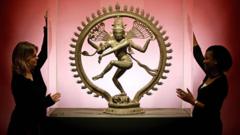The Chola dynasty, which rose to prominence around 1000 CE, transformed the landscape of southern India with its remarkable achievements in architecture, trade, and cultural development. Under the reign of King Rajaraja Chola, their crowning architectural masterpiece, the Brihadishvara temple, was constructed, towering at an impressive height of 216ft and featuring lavish decorations including gold and precious gems. The Cholas also established a powerful economic system that supported agriculture, public works, and monumental temples.
Rajaraja Chola’s innovative governance model and military conquests enabled the dynasty to extend its influence into Sri Lanka and the Deccan plateau, making them a dominant force in the region. His successor, Rajendra Chola, further broadened the empire's reach, fostering connections with Tamil merchants, which laid the groundwork for future trade networks.
The Chola period was marked by a rich cultural exchange, with Tamil merchants actively engaging in trade across Southeast Asia and forming a diverse, multicultural society. Notable for its artistic excellence, the Chola dynasty produced exquisite metalworks, revered in museums worldwide.
The Chola legacy endures in the fabric of modern Tamil Nadu, evident in established urban centers that grew around these ancient shrines and markets. The remarkable history of the Chola dynasty signifies a golden age of innovation and cultural richness, influencing not only India but the global community.
Rajaraja Chola’s innovative governance model and military conquests enabled the dynasty to extend its influence into Sri Lanka and the Deccan plateau, making them a dominant force in the region. His successor, Rajendra Chola, further broadened the empire's reach, fostering connections with Tamil merchants, which laid the groundwork for future trade networks.
The Chola period was marked by a rich cultural exchange, with Tamil merchants actively engaging in trade across Southeast Asia and forming a diverse, multicultural society. Notable for its artistic excellence, the Chola dynasty produced exquisite metalworks, revered in museums worldwide.
The Chola legacy endures in the fabric of modern Tamil Nadu, evident in established urban centers that grew around these ancient shrines and markets. The remarkable history of the Chola dynasty signifies a golden age of innovation and cultural richness, influencing not only India but the global community.






















